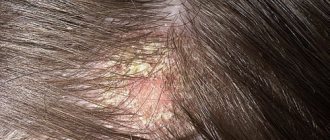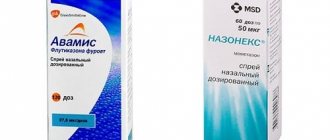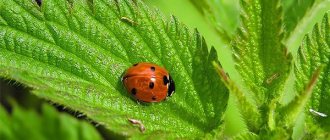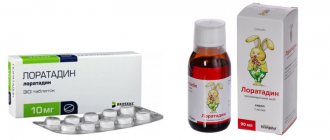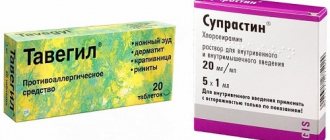Allergy to herbs
Hay fever (seasonal allergic rhinoconjunctivitis, hay fever) is a seasonal disease that develops in sensitized people due to contact with pollen. There are several periods of exacerbation of hay fever: spring, early summer and late summer or summer-autumn. The spring period (April-May) is associated with the flowering of trees (birch, alder, hazel, etc.). Cereal pollen opens the second period - early summer (June-July). The third period of exacerbation of hay fever is late summer (August - September) - the time of flowering of plants from the family Asteraceae and Chenopodiaceae, among which wormwood and quinoa have highly allergenic properties. Let us dwell in more detail on the second and third periods of exacerbation of hay fever, the causes of which are cereals and weeds. Grasses are a large family of plants, containing about 12,000 species. Wild cereals (herbs) are found everywhere in fields and forests, gardens and parks (Table 1). These include chaff, sweet grass, meadow bluegrass, timothy grass, orchard grass, etc. Cultivated cereals include oats, rye, wheat, barley, millet, etc. (Table 2).
| May | June | July |
| Timothy grass | Height: 25-80 cm most often used for lawns | |
| Cocksfoot | Height: up to 1 m inflorescences spiny, in the form of balls | |
| Meadow bluegrass | Height: 30-60 cm so-called. “cockerel or hen?” | |
| fragrant spikelet | Height: 25-80 cm often used in perfumery | |
| Chaff (ryegrass) | Height: up to 1 m inflorescences located on both sides of the stem |
Table 1. Wild cereals
| Oats | Wheat | Barley | Corn |
Table 2. Cultivated cereals Weeds include plants of several families: goosefoot, Asteraceae, plantain. The most famous “allergy culprits” among weeds, depending on the region, are wormwood, ragweed and quinoa (Table 3).
| August | September |
| Sagebrush | Height: 3-150 cm Flowers are extremely small, often yellow, sometimes reddish, collected in small fruits - smooth, small achenes without a tuft. |
| Quinoa | Height: up to 1 m Plants are often covered with silvery hairs, which makes them look like they have been sprinkled with flour. |
| Ambrosia | Height: 20-180 cm, sometimes up to 2 meters. In appearance and shape of the leaves it resembles common wormwood - Chernobyl. It is found more often in the south of Russia |
Table 3. The most allergenic weeds During the flowering period, grass pollen is carried by the wind over long distances. Allergies manifest themselves in the form of a runny nose, nasal congestion, sneezing, burning or itching in the nose and mouth, conjunctivitis, cough, and in some cases, attacks of suffocation. The condition during seasonal exacerbation of hay fever resembles a “cold”, but the temperature often remains normal. At the height of the disease, general symptoms may be observed - the so-called “pollen intoxication”: irritability, fatigue, sleep disorders, fatigue. Patients with grass pollen allergies may also experience allergy symptoms after eating certain foods (Table 4). The reason for the so-called “cross allergy” lies in the biological similarity of plants belonging to the same family and having allergens similar in structure.
| Pollen | Food | Medicinal plants |
| Cereals (timothy, fescue, orchard grass, oats, wheat, barley, rye, corn, etc.) | Beer, kvass, corn, peanuts, legumes, cereals and pasta, bread and bakery products or other products, cereal products or products containing flour; strawberries strawberries citrus, sorrel | Sprouted cereals, all cereal herbs |
| Ambrosia | Melon, bananas, sunflower seeds (seeds, oil, halva), chicory, honey | Dandelion |
| Quinoa | Beetroot, spinach | Beet juice, spinach |
| Wormwood, dahlia, chamomile, dandelion, chrysanthemum, cornflower, sunflower | Sunflower oil and halva, mayonnaise, mustard, chicory; drinks prepared using wormwood (vermouths, balms, martinis); melons; herbs and spices (celery, dill, cumin, parsley, curry, pepper, anise, nutmeg, cinnamon, ginger and coriander), carrots, garlic, citrus fruits, bananas, beets, spinach | Wormwood, chamomile, calendula, chicory, string, elecampane, coltsfoot, tansy, plantain, yarrow |
Table 4. Cross allergens Diagnosis of allergies is of great importance, since it determines further tactics for patient management. It is based on a detailed assessment of the clinical picture of the disease in combination with a special examination, including a blood test for specific immunoglobulins E and/or skin allergy tests. After establishing the cause of the allergy, the doctor prescribes treatment: symptomatic (antihistamines, local anti-inflammatory and antiallergic drugs) and pathogenetic, i.e. aimed at the cause of the allergic disease. Currently, the only method with proven effectiveness is Allergen-Specific Immunotherapy (ASIT). ASIT consists of sequentially introducing certain doses of allergens into the human body: during the initial phase of treatment (up to 4 months), the administered doses gradually increase, then during the maintenance phase the same dose of allergen is administered for 3 years. The full course of treatment lasts about 3 years, after which the patient experiences long-term remission and immunity to the allergen. There are two main methods of administration: subcutaneous and sublingual. Currently, the sublingual route of administration is more relevant - tablets are taken under the tongue, dissolved and then swallowed. ASIT allows you to relieve symptoms of the disease, avoid subsequent sensitizations, and prevent the development of bronchial asthma. The EMC Dermatology and Allergology Clinic conducts all types of diagnostics of seasonal and other forms of allergies, and also offers modern methods of treating hay fever.
The appearance of an allergic reaction
An allergy to cereal grasses usually makes itself felt immediately after contact with the allergen. If the smell of freshly cut grass, poplar fluff flying around the city, or just a walk in June-July along your favorite park alleys or fields causes you to sneeze frequently, tears in your eyes, and you feel nasal congestion, it means that your body is very sensitive to some pollen allergens. then cereal grasses. Now you know that the cereal allergen causes many allergic reactions, and you can easily suspect something is wrong.
90% of people who suffer from hay fever also have serious food allergies. It is for this reason that experts recommend that patients follow a special hypoallergenic diet, especially during the dusting period of dangerous plants, as mentioned above - June-July.
What to do and how to get rid of the disease?
Unfortunately, specialists still do not know of a single treatment method that would completely eliminate allergies. However. With proper treatment and full compliance with the rules of prevention, the occurrence of an allergic reaction can still be minimized.
What is the treatment for grass allergy? The most promising method of treating this allergy is considered to be specific modern immunotherapy with allergens. What does this mean? A specialist injects special concentrated solutions of the allergen into the skin of an allergic person for a month or two so that the body gets used to the irritant.
As a rule, such immunotherapy is carried out in advance, so that by the time cereal grasses begin to bloom, the body’s sensitivity to their pollen is less. This method is contraindicated if there are any signs of the patient’s serious condition. You should also know that this therapy requires special patience. After all, in order to achieve the best results, you will have to spend at least three years. Due to the duration of such therapy, drug treatment is now considered the most common treatment.
Nowadays, there are quite a few antiallergic drugs that differ in the time of their effect on the body and in the number of their side effects. If there are pronounced signs of an allergy to cereal grasses, it is recommended to use one of the following medications:
Treatment of allergies using folk remedies is considered much more effective than drug treatment. A large number of recipes for each of the allergies, no side effects, absolutely no stress on the kidneys and liver - this is just a small list of the advantages of treating allergies using traditional methods. Let's look at one good recipe that traditional medicine offers us.
Take a spoonful of bran. They need to be brewed with boiling water and eaten after a couple of minutes. This must be done in the morning on an empty stomach, but before doing this it is important to drink a mug of water first. In just fifteen minutes your eyes will stop itching and running, and your nasal congestion will disappear.
In severe cases of the disease, it is recommended to combine this course of treatment with taking antiallergenic drugs.
To the village, to the sea or to the mountains?
In rural areas, even if everything blooms there the same as in the city, allergies are still easier to tolerate, because the environment is better there. But, of course, if the flowering of dangerous plants in the area where you are going is in full swing, and everything is already over at home, then it is better to postpone your vacation or go to another place.
Article on the topic
To the sea or to grandma's? Experts on whether you should take your child to a resort Well, if you decide to spend your vacation in other countries, then it is better to choose the sea or the mountains. Sea air reduces the manifestation of allergies, and the sun promotes the production of vitamin D, which strengthens the immune system. However, it is important that the vacation lasts at least 3 weeks. Taking a child to the seaside for just a week is not only useless, but even harmful. Acclimatization and re-acclimatization are extra stress for the immune system, which plays a major role in the development of allergies.
Many excellent resorts suitable for allergy sufferers are located in Crimea, Abkhazia, and the Krasnodar Territory. But it’s better not to go to popular Sochi - it’s too hot and humid there. In Evpatoria the microclimate is much better. Doctors often recommend that allergy sufferers vacation in Bulgaria, Israel, Slovenia, Spain, Italy, Cyprus, Crete, and Turkey (especially in Kemer, where it is not very hot and there are many pine trees). Baltic Sea resorts (Svetlogorsk, Baltic cities) are also favorite vacation spots for parents and children suffering from hay fever. But it’s better not for allergy sufferers to travel to distant Southeast Asia (Thailand, for example). It is too humid and hot there and there are too many different plants. Therefore, it is very difficult to predict what a child with hay fever will react to.
Be careful, chemistry! What household products can cause allergies? More details
Treatment
Allergies to meadow grasses are treated comprehensively. At the first stage, it is necessary to exclude the patient’s contact with the pollen that causes the reaction. It is advisable for allergy sufferers to strictly limit their exposure to air. This requirement is most relevant for dry, windy weather. On such days, you shouldn’t even keep the windows open. Experts recommend using air purification devices that can absorb plant pollen. It is imperative to remove from the diet foods that can provoke cross-type allergic manifestations.
Therapy for allergies of varying severity
If hay fever develops in a mild form, then antihistamines are required. When taken orally, it is preferable to use Astemizole, Fexofenadine or Loratadine. Sprays are suitable for local use, among which Levocabastine and Azelastine have positive reviews.
In case of a moderate allergic reaction, the administration of local glucocorticosteroids would be preferable. Triamcinolone or Fluticasone spray will do. Mometasone and Beclomethasone demonstrate effectiveness. For patients with bronchial asthma, it is advisable to use inhaled glucocorticosteroids. If the problem occurs against the background of infections of viral, bacterial, fungal origin or immune-type malfunctions, then glucocorticosteroid drugs are taken with increased attention.
Severe hay fever is treated with a combination of topical glucocorticosteroids and general antihistamines. If there is increased congestion in the nasal passages, vasoconstrictors Naphazoline, Xylometazoline, Oxymetazoline are prescribed. However, the duration of use is no more than 14 days. Failure to comply with this requirement and abuse of long-term use is highly likely to lead to drug-induced rhinitis.
If the allergy is severe and accompanied by difficulty in nasal breathing, then in most situations surgical intervention is required. The patient is scheduled for surgery to partially remove the turbinates. There are several methods. Among them, laser exposure and cryodestruction are popular.
Use of Antipollina mixed meadow grass
Antipollin mixed meadow herbs is used for complex treatment of allergies. This is a herbal remedy that provides:
- hyposensitizing effect on the body regarding the etiological allergen,
- immunostimulation of immunodeficiency of a secondary nature.
Thanks to taking the drug, the level of tolerance to grass pollen, which causes irritation, increases. As a result, during sensitization, inflammatory changes of an allergic nature are prevented.
Treatment is administered first with small doses, and then the dosage is increased. The purpose is individual depending on the type of plant. Therapy is administered before flowering time.
